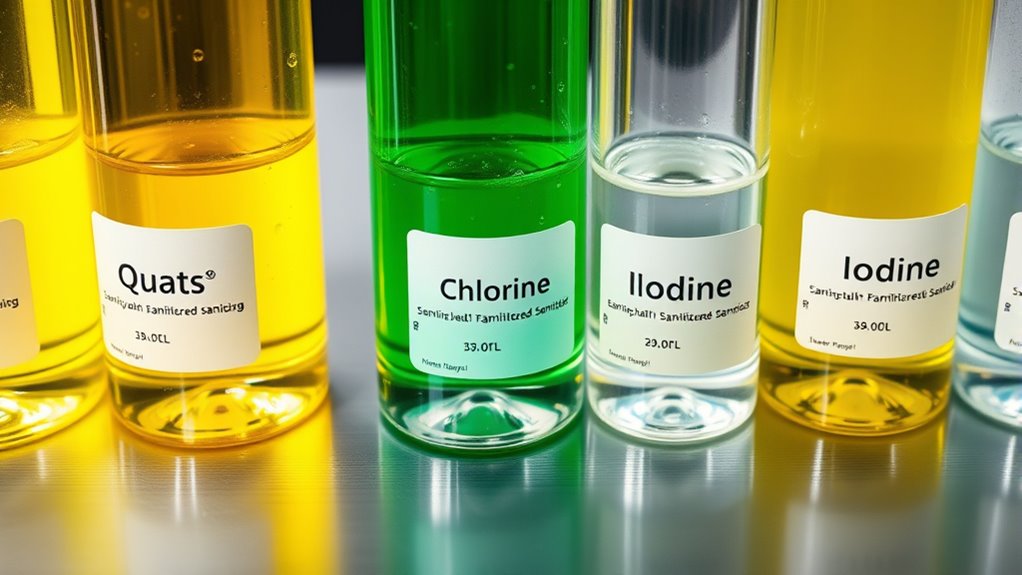Understanding sanitizer types and concentrations is key to effective microbial control. Quaternary ammonium compounds (quats) are common in disinfectant wipes and sprays, typically used at specific concentrations for broad-spectrum activity. Chlorine-based solutions, often used in water treatment and hospitals, require proper dilution for safety and effectiveness. Iodine-based sanitizers are valued for rapid action, especially in healthcare. To ensure safe use and ideal results, it’s important to follow recommended concentrations—stay tuned to learn more about how each type works and their best applications.
Key Takeaways
- Quaternary ammonium compounds (Quats) are effective disinfectants found in sprays and wipes, typically used at concentrations around 0.1% to 0.2%.
- Chlorine-based sanitizers often use sodium hypochlorite, with effective concentrations ranging from 50 to 200 ppm for surface disinfection.
- Iodine sanitizers usually contain povidone-iodine or iodine solutions, effective at concentrations of 2% to 10% for skin and surface sterilization.
- Proper formulation and concentration are critical for sanitizer efficacy and safety, with over- or under-concentration reducing effectiveness.
- Safety precautions, including PPE and ventilation, are essential during use, especially for chlorine and iodine-based products.

Have you ever wondered what makes a sanitizer effective? The key lies in understanding how sanitizers are tested for their effectiveness and ensuring proper safety precautions. Effectiveness testing involves rigorous procedures to confirm that a sanitizer can reliably reduce or eliminate harmful microorganisms on surfaces or skin. This process typically includes exposing the sanitizer to specific microbes under controlled conditions and measuring how well it performs. For you, knowing that a sanitizer has undergone thorough testing gives confidence in its ability to protect against germs. However, safety precautions are just as important as effectiveness testing. Using sanitizers improperly or selecting the wrong type can lead to health risks or reduced efficacy. Always read labels and follow manufacturer instructions closely to avoid issues like skin irritation, inhalation hazards, or chemical misuse.
Understanding sanitizer effectiveness and safety ensures proper use and reliable protection against germs.
When it comes to sanitizer types—quaternary ammonium compounds (quats), chlorine, and iodine—they each have unique properties and application guidelines. Quats are popular for their broad antimicrobial activity and are often found in disinfectant sprays and wipes. They’re effective against bacteria, viruses, and fungi. However, their effectiveness depends on proper formulation and concentration. During effectiveness testing, labs verify that quat-based sanitizers can maintain their antimicrobial activity over time and under different conditions. Safety precautions with quats include wearing gloves and ensuring good ventilation, as prolonged exposure or improper use can cause skin irritation or respiratory issues. Additionally, effectiveness testing ensures these products meet safety and performance standards before reaching consumers.
Chlorine-based sanitizers, such as sodium hypochlorite solutions, are widely used in hospitals, food processing, and water treatment. They’re highly effective against a broad spectrum of microbes, including bacteria and viruses, especially when used at the right concentration. Effectiveness testing for chlorine sanitizers involves checking their microbial kill rates at various dilutions. Safety precautions are critical here because chlorine can be irritating to the skin, eyes, and respiratory system. It can also produce harmful fumes if mixed with other chemicals. Always dilute chlorine solutions properly, wear protective gear, and ensure good ventilation during use.
Iodine-based sanitizers are valued for their rapid action and continued effectiveness in various environments. They’re often used in healthcare settings for hand disinfection and surface sterilization. Effectiveness testing confirms that iodine sanitizers maintain their antimicrobial properties over time and across different surfaces. Safety precautions include avoiding excessive skin contact, as iodine can cause allergic reactions or skin staining. Use in well-ventilated areas and follow recommended concentrations to prevent potential health hazards.
Frequently Asked Questions
How Do Sanitizer Types Vary for Different Industries?
You should know that sanitizer types vary across industries to meet industry-specific sanitizer standards and guarantee safety. For example, food processing uses food-safe sanitizers, while healthcare relies on hospital-grade disinfectants. You must consider cross industry sanitizer compatibility to prevent contamination or equipment damage. By understanding these differences, you can select the right sanitizer for each setting, maintaining safety, compliance, and effective sanitation tailored to each industry’s unique needs.
Can Sanitizer Concentrations Be Adjusted for Specific Surfaces?
You can absolutely adjust sanitizer concentrations for specific surfaces, but it’s a delicate balance. Surface-specific efficacy depends on proper concentration customization; too low, and germs survive; too high, and you risk damage or safety issues. Always follow manufacturer guidelines and industry standards to guarantee effective sanitation without compromising surface integrity. Careful calibration ensures you protect both your surfaces and your team, creating a safer environment.
Are There Eco-Friendly Sanitizer Options Available?
Yes, eco-friendly sanitizer options are available. You can choose biodegradable formulas made from plant-based ingredients that effectively disinfect while minimizing environmental impact. These sanitizers often contain natural compounds like essential oils or plant extracts, making them safe for surfaces and users. Switching to eco-friendly sanitizers helps protect the environment, supports sustainability efforts, and ensures safe use around food and sensitive areas.
How Long Do Sanitizer Effects Last After Application?
You might wonder how long sanitizer effects last after application. The duration durability varies depending on the sanitizer type and environment. Typically, the residual lifespan can range from a few minutes to several hours. Factors like surface type, contact frequency, and cleaning routines influence how long the sanitizing effect endures. Stay vigilant, as the residual lifespan matters in maintaining ongoing hygiene and preventing contamination effectively.
What Safety Precautions Are Necessary When Handling Sanitizers?
When handling sanitizers, you should always wear protective gear like gloves and goggles to prevent skin and eye irritation. Make certain good ventilation in the area to avoid inhaling fumes, especially with chlorine or iodine-based products. Follow manufacturer instructions carefully, and wash your hands thoroughly after use. By taking these precautions, you minimize health risks and ensure safe handling of sanitizers during application and cleanup.
Conclusion
Remember, choosing the right sanitizer is like selecting the key to a locked door—you hold the power to open safety or invite harm. Quats, chlorine, and iodine each serve as guardians against germs, but only when used at the right strength. Treat these tools with respect, and they’ll stand as your shield in the battle for cleanliness. Your careful choice and proper concentration become the symbol of your commitment to health and protection.







